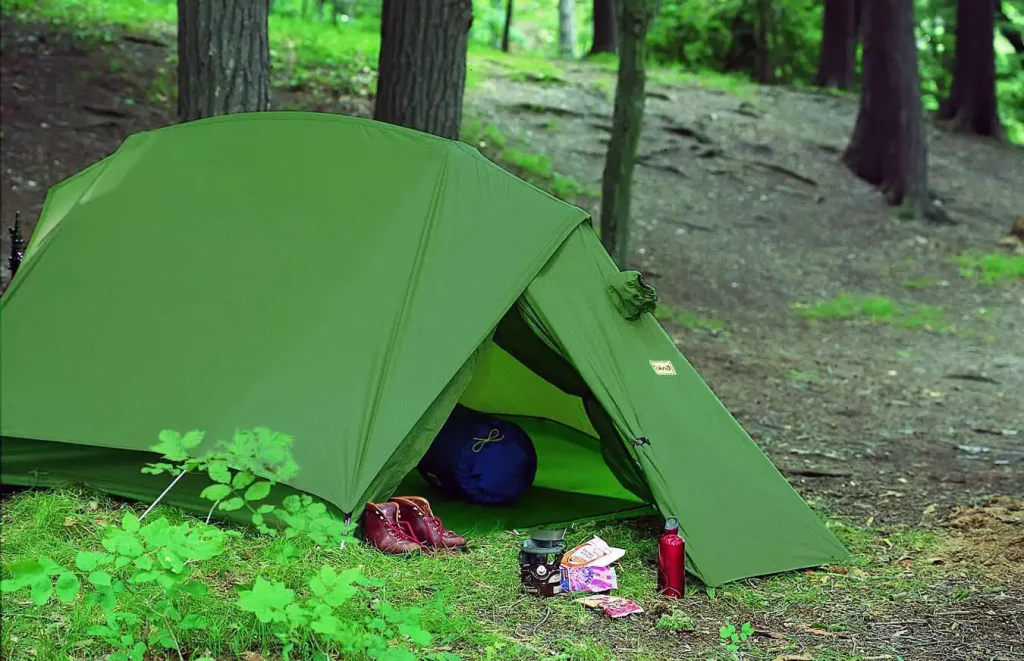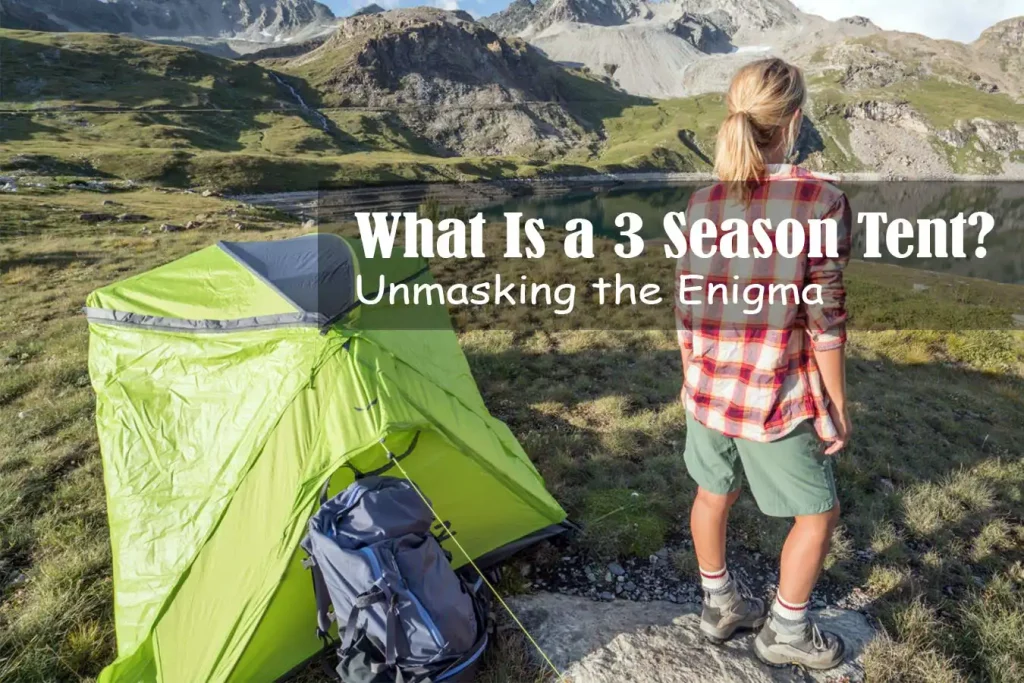Unraveling the mystery, “What is a 3 season tent?” is a question on many outdoor enthusiasts’ minds.
As the name implies, it’s more than just a camping accessory, but what exactly sets it apart?
So, what’s the buzz about these 3 season wonders?
Grab your camping gear, and let’s unravel this mystery together. Time to turn you into a tent pro!
Definition of a 3 Season Tent
What is a 3 Season Tent?
A 3 season tent is a type of outdoor shelter designed for use in the spring, summer, and fall. These tents are crafted to withstand moderate weather conditions typically encountered during these seasons, including light rain, wind, and slightly chilly temperatures.
However, they’re not designed to withstand heavy snowfall or harsh winter conditions, hence the name “3 season.”
Primary Characteristics of a 3 Season Tent
These tents typically feature mesh panels for enhanced airflow, reducing the inside temperature and keeping bugs out. They are equipped with a rainfly for rain and dew protection, but they are not designed to withstand heavy snowfall or fierce winter winds. However, they can typically weather a surprise cold snap or a light snowfall.
Here are some prominent features you’ll find in most 3 season tents:
- Lightweight Design: 3 season tents are usually lighter than their 4 season counterparts. This is because they don’t need the additional materials and reinforcements designed to withstand heavy snow and extreme cold, making them an ideal choice for backpackers mindful of their pack weight.
- Ventilation: A standout feature of 3 season tents is their excellent ventilation. They often have large mesh panels to allow air to flow freely, reducing condensation inside the tent and making them cooler during the warm summer months.
- Rainfly and Weather Protection: 3 season tents come equipped with a rainfly that covers the top of the tent to provide protection against rain and dew. While they’re not built for heavy snowfall or high-speed winds, they can handle light to moderate wind and rain, ensuring you stay dry and comfortable.
- Ease of Use: Typically, 3 season tents are less complex and easier to set up than 4 season tents. They have fewer poles and simpler designs, which can be a blessing when you’re trying to set up camp as the sun is setting!
- Versatility: Given their balance between weather resistance and ventilation, 3 season tents are versatile, suitable for a wide range of camping conditions from a sunny beach camp to a breezy hilltop.
Types of 3 Season Tents
Freestanding 3 Season Tents
Freestanding tents are a popular choice among campers and for good reason. These tents stand up on their own thanks to a structure of interlocking poles. You can set them up without the need for stakes, ropes, or anchors, hence the name “freestanding.” A example of Eureka! Timberline 3 Season 4 Person Backpacking tent from Amazon is given below:

They are super convenient because you can easily pick them up and move them around your campsite until you find the perfect spot. Freestanding 3 season tents often have a dome or cabin-style design, offering a good balance between living space, stability, and wind resistance.
Non-Freestanding 3 Season Tents
On the other hand, non-freestanding tents, sometimes known as “semi-freestanding” or “tunnel tents,” rely on stakes, guy lines, and tension to maintain their structure.
They might require a little more time and skill to set up, but they’re typically lighter than freestanding tents because they use fewer poles. Their design usually emphasizes length over height, providing excellent space for sleeping while keeping a low profile against the wind.
Comparison of Different Types
So, how do you choose between freestanding and non-freestanding tents? Freestanding tents tend to be more user-friendly and versatile. They are often preferred by beginner campers or families who appreciate the ability to move the tent around.
Non-freestanding tents, on the other hand, are typically lighter and more compact, making them a favorite choice among backpackers and solo adventurers. Remember, the best tent for you will ultimately depend on your specific camping needs and preferences.
Read more: How Much Does a Tent Weigh
Components of a 3 Season Tent
Tent Material and Construction
The material of a tent plays a crucial role in its durability, weather resistance, and weight. Most 3 season tents use nylon or polyester for the canopy and rainfly, given their strength, light weight, and water-resistant properties.
Some high-end tents might feature ripstop versions of these fabrics, offering added durability. The floor of the tent is often made of a thicker, more robust material to resist wear and tear.
Ventilation System
One defining feature of 3 season tents is their focus on ventilation. These tents often incorporate large mesh panels in the canopy, allowing for maximum airflow and minimizing condensation. The mesh also serves as a barrier against bugs and insects, a vital feature when camping in warmer months.
Rainfly and Weather Protection
A rainfly is a separate waterproof cover designed to fit over the roof of your tent. For 3 season tents, the rainfly provides protection from rain, dew, and sometimes offers extra UV protection. Many 3 season tents come with a full-coverage rainfly, offering optimum weather protection. Some models might also have a vestibule space under the rainfly, providing a sheltered area for gear storage.
Tent Poles and Setup Mechanism
Most 3 season tents use aluminum poles, given their strength and lightweight properties. The number and configuration of poles influence the tent’s stability and setup time.
Dome-style tents often use two intersecting poles, making the setup intuitive and quick, while tunnel-style tents might have multiple parallel poles requiring more attention during setup. Some tents feature color-coded corners and poles, or clips and buckles, making the setup process even easier.
Know more: Is Tent Camping Safe
Benefits of Using a 3 Season Tent
Versatility
The primary advantage of a 3 season tent is its versatility. As the name implies, these tents are designed for spring, summer, and fall use. They are built to withstand everything from balmy summer nights to early fall frost, as well as a decent amount of rainfall.
You can use them for anything from backpacking trips and festival camping to recreational family camping, making them a multi-purpose choice for many outdoor enthusiasts.
Lightweight Design
3 season tents prioritize weight reduction and packability, ideal for those who need to carry their gear for extended periods. The materials used, like nylon or polyester, and the design characteristics, such as fewer poles or reduced wall material, contribute to this lighter weight. This feature makes 3 season tents a favorite among backpackers, hikers, and cyclists.
Weather Resilience
While they might not be suitable for harsh winters or high-mountain expeditions, 3 season tents are quite adept at handling various weather conditions. From unexpected summer showers to windy afternoons, the rainfly, sturdy construction, and well-placed guy lines of these tents provide adequate weather resilience for most campers.
Cost-Effectiveness
In general, 3 season tents are less expensive than their 4 season counterparts. The savings come from the less intense specifications required for three seasons of use rather than four. Therefore, for those who don’t plan on winter camping, a 3 season tent provides the functionality needed at a more accessible price point.
Limitations of a 3 Season Tent
Inadequate for Extreme Weather
Despite their weather resilience, 3 season tents are not designed for harsh winter conditions, heavy snow, or extreme winds. If you’re planning a winter camping trip or heading into high-altitude terrain with unpredictable weather, a 4 season tent would be a safer choice.
Condensation Issues
Because of their emphasis on ventilation, 3 season tents can sometimes struggle with condensation in colder, wet conditions. The large mesh panels can let in cold air, dropping the interior temperature and causing moisture to condense inside the tent.
Choosing the Right 3 Season Tent
Factors to Consider When Buying a 3 Season Tent
When purchasing a 3 season tent, consider the tent’s weight and packed size, especially if you’ll be carrying it for long distances. Additionally, look at the tent’s capacity to ensure it can comfortably accommodate your group size.
Finally, consider the setup process, weather resilience, and durability – you’ll want a tent that can stand up to the conditions you plan to camp in and last for several seasons.
Essential Features to Look for in a 3 Season Tent
When choosing a 3 season tent, look for features that will enhance your camping experience. A full-coverage rainfly, large vestibules for gear storage, a robust ventilation system, and durable tent material are all important.
Additionally, interior features such as gear lofts, lantern hooks, or pockets can improve the tent’s functionality and make your camping trip more enjoyable.
Choosing the right 3 season tent requires careful consideration and an understanding of your camping needs. But once you’ve made the right choice, you’re all set for countless adventures in the great outdoors.
Learn more: What is a Hot Tent
Care and Maintenance of a 3 Season Tent
Cleaning and Storing Your Tent
Just like any other piece of outdoor equipment, a 3 season tent needs regular care and maintenance to prolong its lifespan.
After each camping trip, shake out any dirt or debris and clean the tent with a mild soap, avoiding harsh detergents that can damage the tent material. Use a soft sponge to gently scrub any dirty areas, then rinse thoroughly with cold water.
Ensure your tent is fully dry before storing it to prevent mold or mildew growth. Always store your tent loosely packed, preferably in a large cotton or mesh storage sack, not the compact travel sack used for backpacking.
Storing your tent in a cool, dry place out of direct sunlight will also help to prolong its lifespan.
Repairing Damage and Prolonging Tent Life
Despite our best efforts, accidents happen. Whether it’s a small tear in the tent fabric, a broken pole, or a zipper that’s seen better days, most damages can be repaired. Specialized tent repair kits are available and usually include fabric patches, seam sealer, and pole repair splints.
To prolong the life of your tent, try to pitch it on soft, level ground free of sharp objects. Using a footprint or ground cloth not only protects the tent floor but also keeps it clean. Regularly check and tighten the guy lines and be mindful of your tent’s exposure to harsh UV rays, as they can degrade the fabric over time.
Also learn: How Much Should a Backpacking Tent Weigh
FAQs About 3 Season Tents
Can you use a 3 season tent in winter?
What does it mean for a tent to be 3 season?
What temperature is a 3 season tent good for?
Is 3 season tent good for rain?
How do you winterize a 3 season room?
What tent is best for winter?
Last Words
In summary, a 3 season tent is a versatile and cost-effective choice for outdoor enthusiasts who camp in spring, summer, and fall. With a range of types and components to choose from, these tents are designed to be lightweight and weather-resilient.
However, they have limitations in extreme weather conditions and sometimes struggle with condensation issues.
Choosing the right 3 season tent involves careful consideration of several factors, including weight, packed size, capacity, and specific features. Once chosen, proper care and maintenance of your tent, including correct cleaning, storage, and repair, will ensure it lasts for many adventures to come.


